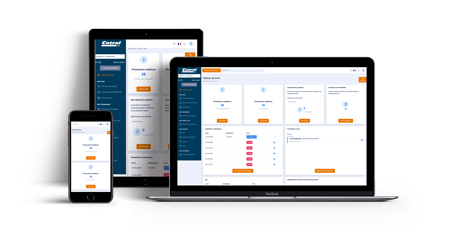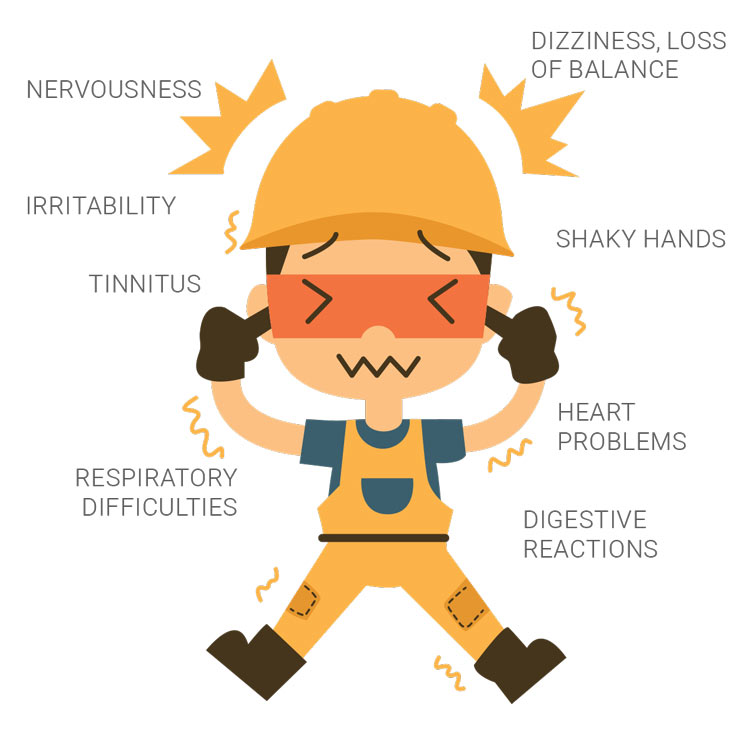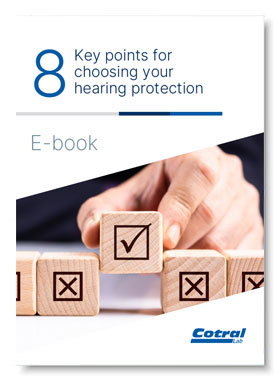Because protecting hearing is essential, Cotral Lab has been offering custom-made ear plugs to professionals exposed to noise for more than 25 years.
Are you getting kitted out? Will you soon take part in a Cotral Lab ear impression session? You will find below all the detailed steps with images and video to best support you in your prevention strategy.
SUMMARY
- Organisation and discussion with your Cotral Lab prevention technician
- The procedure for taking ear impressions
- Timeframe for receiving your custom-made hearing protection
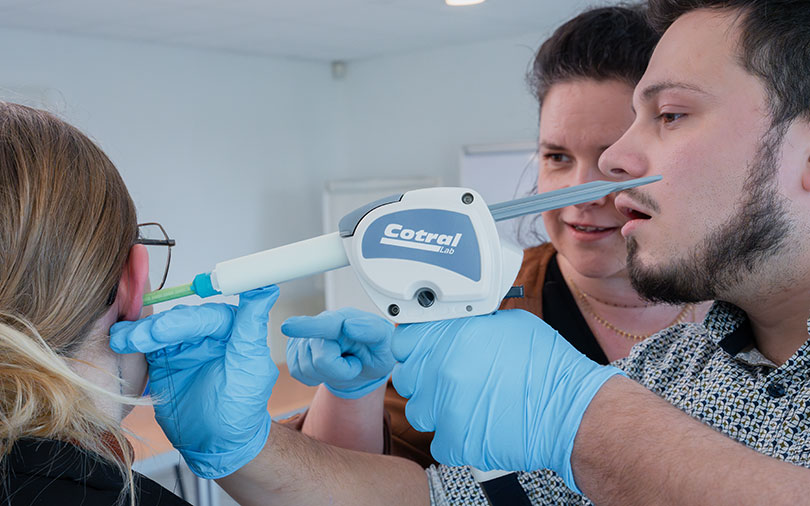
Organisation and discussion with your prevention technician
The Cotral Lab prevention technician's visit will have been arranged in advance with the company's contact person. (Health and Safety Manager / Nurse / Safety Coordinator, etc.).
We advise you to provide a space large enough to accommodate several people (meeting room) and to block a 30 to 40-minute slot for a group of five people, or 1 to 1.5 hours for a group of 10 people.
The technician will have a discussion with you about any persons suffering from earwax blockages or earaches and will ask you to recommend a consultation with their GP/ENT.
On the day, we ask that the room provided for taking impressions be equipped with chairs and tables and possibly a video projector to display the prevention technician's informational aids.
Cotral Lab procedure for taking ear impressions
Impressions are taken in 6 steps:
#1 Raising awareness and informing employees about noise risk
When working in a noisy environment, the primary objective of any company in terms of prevention is to preserve the hearing of its employees and make them more comfortable.
That's where Cotral Lab comes in.
A service provider since 1996, Cotral Lab uses its know-how and the experience of its prevention technicians, who are also trainers, to spread awareness during the impression-taking sessions.
Cotral Lab has developed its own pedagogical tools and provides the following information during the sessions:
- Ear function
- Awareness of the risks of noise exposure and how to protect oneself
- Raising awareness about the proven well-being and health benefits of protecting oneself
- Function and advice on the use of Cotral Lab hearing protection (fitting, adjustment period, hygiene, etc.)
- Techniques used when taking impressions and the sensations felt.
The Cotral Lab prevention technician will begin their session at your establishment with a refresher on basic concepts, in order to raise awareness of noise risks and also to answer any questions you or your employees may have.
They will then of course provide information about how the impressions will be taken, among other things.
The technique used is explained to the person along with a warning about the sensation felt in the ear. (A slight cough may be triggered when inserting the foam, for example).
The prevention technician will also ask the future wearer about any possible ear surgeries, pain or infections.
#2 Selection of the type of acoustic protector and filter - SAPAN method
In order to best determine the needs of each person, the prevention technician follows the SAPAN method.
SAPAN was developed by HearingProTech, a leading expert on noise. It is a method that follows the recommendations of the EN-458 standard.
It allows the attenuation of the protection to be customized so that it can be worn for 100% of the noise exposure time; the only guarantee of effective protection.
A system recognised for its reliability, it selects the hearing protection best suited to the environment and the characteristics of the future wearer, taking into account various criteria:
- Noise exposure levels
- Constraints and specificities of the employee, in particular the need for communication and/or perception of the environment
- Actual attenuation values of the custom hearing protection
- Recommended levels of perception
The technician will then enter the employee's information via the software accessible on their smartphone and select the filter/protection combination most appropriate for the employee's situation.
The technician then scans the QR code on the bag. This QR code will later be used to identify the employee's impressions.
#3 Otoscopy and eardrum protection
The prevention technician systematically performs an otoscopy of the person's ear canal to identify any contraindications to taking an impression (earwax blockage, otitis-related inflammation, recent surgery, etc.).
In the event of total or sub-total tympanic membrane perforation, the advice of a physician is mandatory.
The technician places the disposable speculum on the otoscope to check that the ear canal is healthy and that the eardrum is clearly visible.
The technician inserts a foam into the ear canal using the Otopen insertion device. This foam has a wire that allows for removal.
The purpose of this is to protect the eardrum, to stop the flow of the impression paste, and to limit the phenomenon of high and low pressure in the ear.
The location of the foam must be checked via the otoscope.
#4 Taking impressions
Using an impression gun, the technician will inject the impression paste into each ear.
The person being fitted should then remain still and not speak while the paste is drying.
They should keep their mouth naturally closed and relaxed.
#5 Removing the paste
Once the impression has dried (after 3 to 5 minutes), the prevention technician gently removes it.
The technician removes the hook and then rotates it. The impression automatically "unscrews" from the ear canal.
The prevention technician checks that the impression is complete (foam and impression), that it corresponds to the morphology of the ear, and does not contain any anomalies, such as air bubbles or folds.
If the impression is not correct, the prevention technician will repeat the procedure.
#6 Sending impressions to Cotral Lab headquarters
After checking the impressions, the prevention technician places them in a bag specific to each employee and sends the whole set to the Cotral Laboratory where the personal hearing protection is manufactured.
Cotral Lab procedure for taking ear impressions
Timeframe for receiving your custom-made Cotral Lab hearing protection
You should receive your custom-made Cotral Lab hearing protection 4 weeks after impressions are taken.
The package, depending on the type of contract, includes plugs, cord, case and possibly a hearing protection maintenance kit.
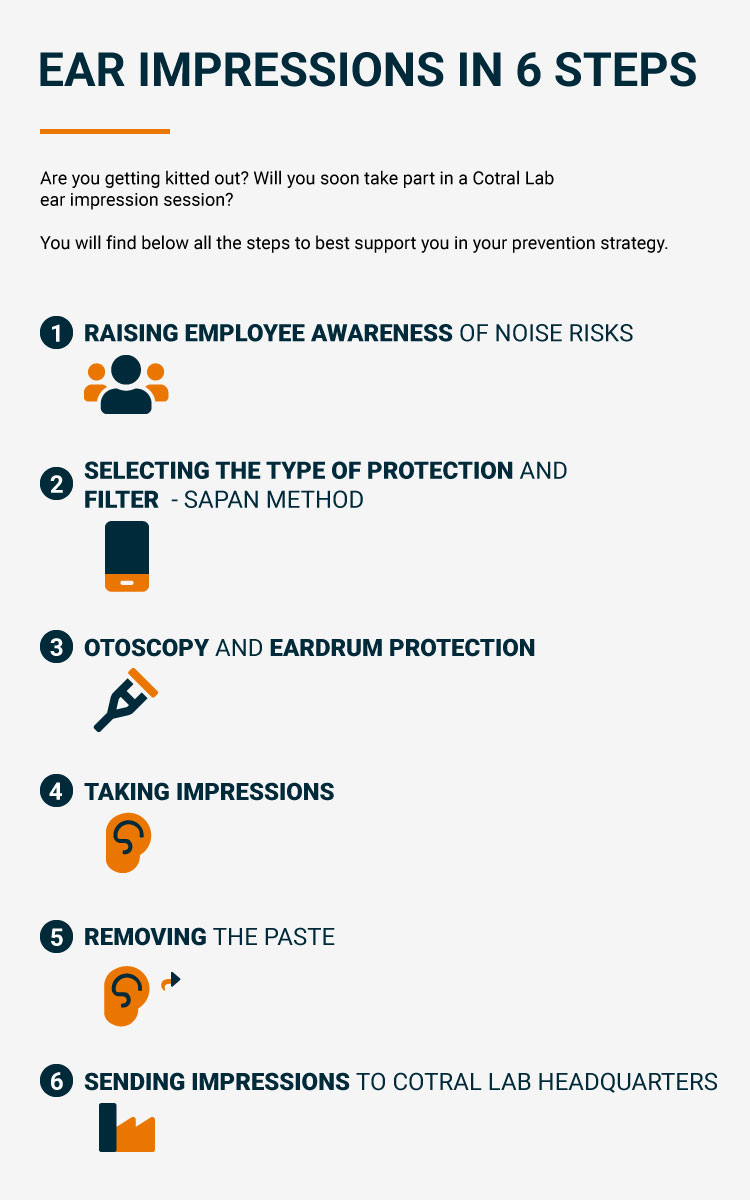
Find out how to fight noise by downloading your white paper "6 essential elements against noise at work".
Related articles
